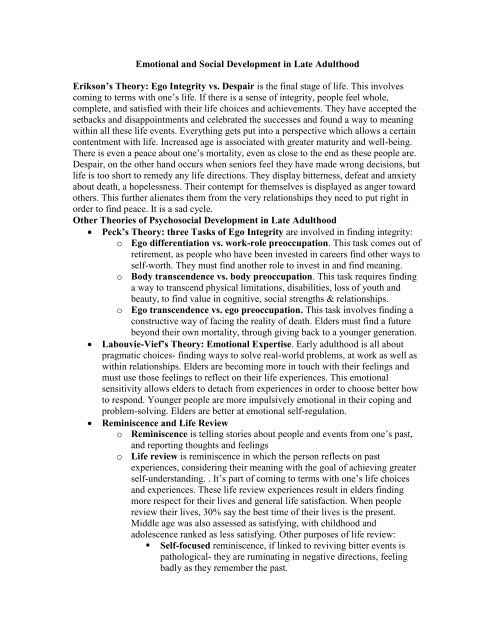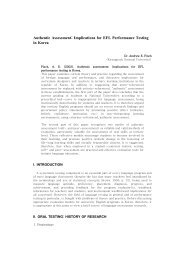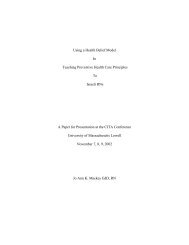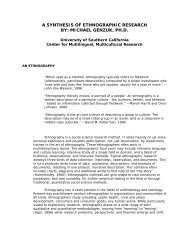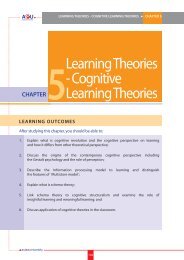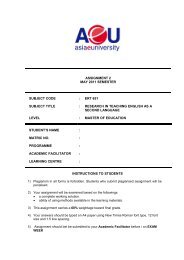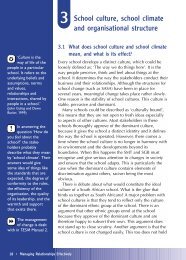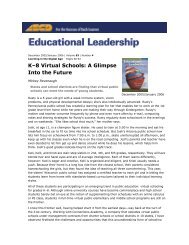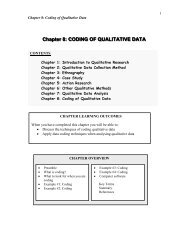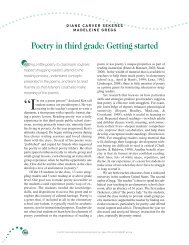Emotional and Social Development in Late Adulthood
Emotional and Social Development in Late Adulthood
Emotional and Social Development in Late Adulthood
Create successful ePaper yourself
Turn your PDF publications into a flip-book with our unique Google optimized e-Paper software.
<strong>Emotional</strong> <strong>and</strong> <strong>Social</strong> <strong>Development</strong> <strong>in</strong> <strong>Late</strong> <strong>Adulthood</strong>Erikson’s Theory: Ego Integrity vs. Despair is the f<strong>in</strong>al stage of life. This <strong>in</strong>volvescom<strong>in</strong>g to terms with one’s life. If there is a sense of <strong>in</strong>tegrity, people feel whole,complete, <strong>and</strong> satisfied with their life choices <strong>and</strong> achievements. They have accepted thesetbacks <strong>and</strong> disappo<strong>in</strong>tments <strong>and</strong> celebrated the successes <strong>and</strong> found a way to mean<strong>in</strong>gwith<strong>in</strong> all these life events. Everyth<strong>in</strong>g gets put <strong>in</strong>to a perspective which allows a certa<strong>in</strong>contentment with life. Increased age is associated with greater maturity <strong>and</strong> well-be<strong>in</strong>g.There is even a peace about one’s mortality, even as close to the end as these people are.Despair, on the other h<strong>and</strong> occurs when seniors feel they have made wrong decisions, butlife is too short to remedy any life directions. They display bitterness, defeat <strong>and</strong> anxietyabout death, a hopelessness. Their contempt for themselves is displayed as anger towardothers. This further alienates them from the very relationships they need to put right <strong>in</strong>order to f<strong>in</strong>d peace. It is a sad cycle.Other Theories of Psychosocial <strong>Development</strong> <strong>in</strong> <strong>Late</strong> <strong>Adulthood</strong> Peck’s Theory: three Tasks of Ego Integrity are <strong>in</strong>volved <strong>in</strong> f<strong>in</strong>d<strong>in</strong>g <strong>in</strong>tegrity:o Ego differentiation vs. work-role preoccupation. This task comes out ofretirement, as people who have been <strong>in</strong>vested <strong>in</strong> careers f<strong>in</strong>d other ways toself-worth. They must f<strong>in</strong>d another role to <strong>in</strong>vest <strong>in</strong> <strong>and</strong> f<strong>in</strong>d mean<strong>in</strong>g.o Body transcendence vs. body preoccupation. This task requires f<strong>in</strong>d<strong>in</strong>ga way to transcend physical limitations, disabilities, loss of youth <strong>and</strong>beauty, to f<strong>in</strong>d value <strong>in</strong> cognitive, social strengths & relationships.o Ego transcendence vs. ego preoccupation. This task <strong>in</strong>volves f<strong>in</strong>d<strong>in</strong>g aconstructive way of fac<strong>in</strong>g the reality of death. Elders must f<strong>in</strong>d a futurebeyond their own mortality, through giv<strong>in</strong>g back to a younger generation. Labouvie-Vief’s Theory: <strong>Emotional</strong> Expertise. Early adulthood is all aboutpragmatic choices- f<strong>in</strong>d<strong>in</strong>g ways to solve real-world problems, at work as well aswith<strong>in</strong> relationships. Elders are becom<strong>in</strong>g more <strong>in</strong> touch with their feel<strong>in</strong>gs <strong>and</strong>must use those feel<strong>in</strong>gs to reflect on their life experiences. This emotionalsensitivity allows elders to detach from experiences <strong>in</strong> order to choose better howto respond. Younger people are more impulsively emotional <strong>in</strong> their cop<strong>in</strong>g <strong>and</strong>problem-solv<strong>in</strong>g. Elders are better at emotional self-regulation. Rem<strong>in</strong>iscence <strong>and</strong> Life Reviewo Rem<strong>in</strong>iscence is tell<strong>in</strong>g stories about people <strong>and</strong> events from one’s past,<strong>and</strong> report<strong>in</strong>g thoughts <strong>and</strong> feel<strong>in</strong>gso Life review is rem<strong>in</strong>iscence <strong>in</strong> which the person reflects on pastexperiences, consider<strong>in</strong>g their mean<strong>in</strong>g with the goal of achiev<strong>in</strong>g greaterself-underst<strong>and</strong><strong>in</strong>g. . It’s part of com<strong>in</strong>g to terms with one’s life choices<strong>and</strong> experiences. These life review experiences result <strong>in</strong> elders f<strong>in</strong>d<strong>in</strong>gmore respect for their lives <strong>and</strong> general life satisfaction. When peoplereview their lives, 30% say the best time of their lives is the present.Middle age was also assessed as satisfy<strong>in</strong>g, with childhood <strong>and</strong>adolescence ranked as less satisfy<strong>in</strong>g. Other purposes of life review:• Self-focused rem<strong>in</strong>iscence, if l<strong>in</strong>ked to reviv<strong>in</strong>g bitter events ispathological- they are rum<strong>in</strong>at<strong>in</strong>g <strong>in</strong> negative directions, feel<strong>in</strong>gbadly as they remember the past.
• Other-focused rem<strong>in</strong>iscence is directed at social goals, family,reliv<strong>in</strong>g relationships with others. These people are moreextraverted, so their memories are more focused on others.• Knowledge-based rem<strong>in</strong>iscence uses the past to solve problems<strong>and</strong> teach younger people. Certa<strong>in</strong> cultures rely on elders tell<strong>in</strong>gthe stories of their people <strong>in</strong> order to enlighten younger members<strong>in</strong> how to live honorably. (Ch<strong>in</strong>ese, African-American, Native-American groups)• Rem<strong>in</strong>iscence also occurs dur<strong>in</strong>g times of life transitionretirement,loss of spouse, moves- these rem<strong>in</strong>iscences allow for afeel<strong>in</strong>g of cont<strong>in</strong>uity <strong>and</strong> mean<strong>in</strong>g <strong>in</strong> the face of change.Stability <strong>and</strong> Change <strong>in</strong> Self-Concept <strong>and</strong> Personality Secure <strong>and</strong> Multifaceted Self-Concept- after a lifetime of self-knowledge,people feel more secure about whom they are, <strong>and</strong> their self-concepts becomemore complex <strong>and</strong> multi-faceted. With that complex knowledge, people can makecompensations <strong>in</strong> areas of weakness, <strong>and</strong> they develop deeper self-acceptance.People def<strong>in</strong>e themselves more broadly, not just <strong>in</strong> terms of work. Healthy eldersreport areas they still hope for development, as if they are still a work <strong>in</strong> progress. Agreeableness, Sociability, <strong>and</strong> Acceptance of Change- there are 3 shifts <strong>in</strong>personality at this po<strong>in</strong>t: a more flexible <strong>and</strong> optimist approach to life is present.o Agreeableness – generosity, acquiescence, <strong>and</strong> good-naturedness arehigher for many people at this po<strong>in</strong>t.o Sociability drops to some extent, as people become more selective aboutrelationships <strong>and</strong> significant people die or move away.o Acceptance of change seems to l<strong>in</strong>k to well-be<strong>in</strong>g. They develop acapacity to accept life’s vagaries, <strong>and</strong> they are resilient <strong>in</strong> the face ofadversity. Spirituality <strong>and</strong> Religiosity- their sense of spirituality encompasses their livesmore mean<strong>in</strong>gfully. Often there develops a sense of truth <strong>and</strong> beauty <strong>in</strong> art, nature,<strong>and</strong> relationships. Religion gives people rituals that stabilize life <strong>and</strong> givemean<strong>in</strong>g to the life struggle. 76% of Americans over 65 say religion is veryimportant <strong>in</strong> their lives, <strong>and</strong> 16% say it is fairly important. They may not be asactive <strong>in</strong> church because of physical limitations or transportation issues, but theysay they would devote more time to it if they could. Spirituality advances to ahigher level <strong>in</strong> late life- to a more reflective approach that is more at ease with theunknowable aspects of life.o Fowler’s Stages of Faith <strong>Development</strong> show there can be a developmentof underst<strong>and</strong><strong>in</strong>g of one’s beliefs <strong>in</strong> relation to others’. Women are morelikely than men to be church members, to be active <strong>in</strong> religious activities,<strong>and</strong> to report a desire to connect with the Div<strong>in</strong>e. It may have to do withwomen’s common cultural roles- caregiv<strong>in</strong>g to various generations,widowhood, greater risk of poverty, unmanageable stress.• Intuitive-projective- 3-7 is when children’s fantasy life allowsthem to be <strong>in</strong>fluenced by stories <strong>and</strong> faith of adults.
• Mythic-literal- 7-11 is when <strong>in</strong>ternalize the stories <strong>and</strong> rituals oftheir faith literally.• Synthetic-conventional- adolescence is when people set up abelief system as a basis for identity.• Individuative-reflective-adulthood is when people reflect on theirbeliefs <strong>and</strong> beg<strong>in</strong> to recognize that others believe other th<strong>in</strong>gs, <strong>and</strong>they more actively form an ideology <strong>in</strong> terms of mean<strong>in</strong>g forthemselves personally.• Conjunctive- <strong>Late</strong> adulthood is when people <strong>in</strong>corporate the entirehuman community <strong>in</strong> their values- to st<strong>and</strong> up aga<strong>in</strong>st persecution<strong>and</strong> work for the good of people they don’t even know.World War II Refugee <strong>and</strong> Evacuee Children Look back at Old Age- thesepeople were either evacuated from Europe <strong>and</strong> Brita<strong>in</strong> early <strong>in</strong> the war to savetheir lives, never to see their families aga<strong>in</strong>, or were evacuated <strong>and</strong> returned totheir families after the war. Their recollections varied accord<strong>in</strong>g to the quality ofcare their received, age at separation, <strong>and</strong> temperament. Care situations werefamilies, <strong>in</strong>stitutions. The better care they got, the more their memories werepositive, but bonds with the former family were often lost. Those who got<strong>in</strong>different care couldn’t bond <strong>and</strong> were left <strong>in</strong> “emotional limbo” without newattachments. This loss of bond<strong>in</strong>g had a last<strong>in</strong>g impact on withdrawn, anxious<strong>in</strong>dividuals than on more extraverted people who found others to bond with. Timeof separation made a difference- children were more affected than adolescents.Teens did better <strong>in</strong> group homes or board<strong>in</strong>g schools. They often found otherpeers to bond with at this po<strong>in</strong>t. Some that lived <strong>in</strong> group homes felt isolated,without love however. Those who were reunited with families were young adults<strong>and</strong> their reunification was bittersweet- s<strong>in</strong>ce both children <strong>and</strong> families hadchanged so much. Without reunification, however, there is idealization of the lostfamily <strong>and</strong> unresolved grief. Those who lost their entire families to the Holocaustfelt the loss even more <strong>in</strong>tensely as time went on. Even so, most people that wentthrough this experience were reasonably well-adjusted, f<strong>in</strong>d<strong>in</strong>g love later, <strong>and</strong>careers. They usually have a strong resilience of spirit, feel<strong>in</strong>g they have alreadyfaced the worst the world could dish out.Individual differences <strong>in</strong> Psychological Well-Be<strong>in</strong>g- what makes the difference <strong>in</strong> aperson’s life adaptation <strong>and</strong> well-be<strong>in</strong>g? Control vs. Dependency- there are 2 common scripts of people help<strong>in</strong>g elderso Dependency-support script is a script <strong>in</strong> which dependent behaviors areattended to immediately, re<strong>in</strong>forc<strong>in</strong>g the weaker member <strong>in</strong> herdependency.o Independence-ignore script is a script where <strong>in</strong>dependent behaviors areignored, also re<strong>in</strong>forc<strong>in</strong>g dependency <strong>in</strong> the weaker member.Unfortunately, be<strong>in</strong>g dependent is not a happy state, so the helper is oftenresented, even though the elder may recognize s/he needs the help. Thesenegative feel<strong>in</strong>gs can foster depression. Context makes a differencehowever, s<strong>in</strong>ce the more lov<strong>in</strong>gly the help is offered, the easier it is to
accept without regret. Elders will need help, but we can offer it withoutexpress<strong>in</strong>g disgust or impatience for their needs.o Elder Suicide is not always evident. Sometimes elders quit eat<strong>in</strong>g, tak<strong>in</strong>gcare of emotional or physical problems, refus<strong>in</strong>g to take meds, refus<strong>in</strong>grelationships that could be encourag<strong>in</strong>g. Suicide peaks <strong>in</strong> late life, around75, especially for men. Five times more elderly men commit suicide aswomen, even though women have greater rates of depression. Womenhave broader networks of social support, however. Men choose moredef<strong>in</strong>itive means of suicide- guns, which allow little resuscitation. Whitepeople are at highest risk, ethnically.o Factors related to Elder suicide- Two life events can prompt suicide:loss- of job, spouse may put people at sea try<strong>in</strong>g to cope <strong>and</strong> adjust; <strong>and</strong>chronic or term<strong>in</strong>al illness that cause pa<strong>in</strong> or dim<strong>in</strong>ish <strong>in</strong>dependentfunction<strong>in</strong>g. Men are so socialized to be active <strong>and</strong> <strong>in</strong>dependent, that ifthey lose that to an illness, they often can’t f<strong>in</strong>d any compensat<strong>in</strong>g aspectsof life.• Prevention <strong>and</strong> treatment – there are some warn<strong>in</strong>g signsputt<strong>in</strong>gaffairs <strong>in</strong> order, veiled statements about go<strong>in</strong>g away, dy<strong>in</strong>g,sleep or appetite changes. There are often self-destructive acts suchas refus<strong>in</strong>g to eat, or go to the doctor, or take meds. As many as70% of suicide victims saw their doctor with<strong>in</strong> a month of tak<strong>in</strong>gtheir lives, yet family nor doctor picked up on signals of despair.They need antidepressant meds, therapy, possibly hospitalizationto deal with the immediate crisis. It’s good if regular home visitorscan be engaged, as well as day activities for the person to lookforward to.Health is a strong predictor of well-be<strong>in</strong>g <strong>in</strong> late adulthood. When people faceillness or chronic disabilities, they feel a loss of personal control. Not only doeshelplessness <strong>in</strong>crease, but social isolation <strong>in</strong>creases, too. Then as mental healthdecl<strong>in</strong>es, it affects physical health, as people eat more poorly, get out less, distractthemselves less from their ailments. If a senior must move to a nurs<strong>in</strong>g home,there is a redef<strong>in</strong>ition of identity, as a person who can survive only <strong>in</strong> an<strong>in</strong>stitution. Many people get seriously depressed <strong>and</strong> deteriorate rapidly <strong>in</strong> anurs<strong>in</strong>g home. Serious depression is associated with suicide. If they can reta<strong>in</strong> anyautonomy <strong>in</strong> an <strong>in</strong>stitution, it contributes to their successful survival.Negative Life Changes occur more often <strong>in</strong> late adulthood- loss of friends,spouses, poor health issues, f<strong>in</strong>ancial stra<strong>in</strong> & greater dependency. This issues hitwomen more often, but they still report that they have people who depend onthem emotionally, so they reta<strong>in</strong> some of their former identity, even though manyrelationships often feel stra<strong>in</strong>ed, due to the women’s lower ability to care forothers.<strong>Social</strong> Support <strong>and</strong> <strong>Social</strong> Interaction – social support reduces stress, so itpromotes health & well-be<strong>in</strong>g, <strong>and</strong> <strong>in</strong>creases the odds of liv<strong>in</strong>g longer. If eldersrequire much assistance from others, though, they often feel distressed that theycan no longer reciprocate. Paid helpers relieve some of that sense of obligation by
elders. Be<strong>in</strong>g more extraverted helps seniors to reta<strong>in</strong> good mood <strong>and</strong> stay active<strong>and</strong> connected to others.A Chang<strong>in</strong>g <strong>Social</strong> World <strong>Social</strong> Theories of Ag<strong>in</strong>go Disengagement Theory- the idea that social <strong>in</strong>teraction decl<strong>in</strong>es becauseof mutual withdrawal between elders <strong>and</strong> society <strong>in</strong> anticipation of death.But not everyone disengages.o Activity theory is the theory that there are social barriers to engagement,not just the desires of elders to disengage. Offer<strong>in</strong>g older adultsopportunities for social contact does not guarantee greater sociability.o Socioemotional Selectivity Theory states that social networks becomemore selective as we age. People limit their contacts to familiar partnerswith whom they have the most reward<strong>in</strong>g relationships. <strong>Social</strong> Contexts: Communities, Neighborhoods, <strong>and</strong> Hous<strong>in</strong>go Communities <strong>and</strong> Neighborhoods- elders liv<strong>in</strong>g <strong>in</strong> the suburbs are betteroff <strong>in</strong> terms of <strong>in</strong>come <strong>and</strong> health, but elders <strong>in</strong> <strong>in</strong>ner cities have greateraccess to social services. Those <strong>in</strong> small towns have the least access.Elders <strong>in</strong> small communities report greater life satisfaction.o Ag<strong>in</strong>g, Time Perception, <strong>and</strong> <strong>Social</strong> Goalso Victimization <strong>and</strong> Fear of Crime – those elders who live alone or <strong>in</strong><strong>in</strong>ner-city areas suffer with fears of crim<strong>in</strong>al victimization. It restricts theiractivities <strong>and</strong> underm<strong>in</strong>es morale.o Hous<strong>in</strong>g arrangements• Ord<strong>in</strong>ary Homes offer seniors the greatest personal control overtheir lives. When health <strong>and</strong> mobility problems appear, liv<strong>in</strong>galone presents safety issues, as well as f<strong>in</strong>ancial difficulties.• Residential communities are designed to offer elders as muchsafety <strong>and</strong> autonomy as is possible. These centers also offerrecreational activities, transportation, & support services. Congregate hous<strong>in</strong>g offers common meals <strong>in</strong> a d<strong>in</strong><strong>in</strong>groom, as well as transportation <strong>and</strong> activities. Life care communities offer a variety of care- from<strong>in</strong>dependent or congregate hous<strong>in</strong>g to full nurs<strong>in</strong>g care.When there is a sense of community, life satisfaction ishigher. Nurs<strong>in</strong>g homes represent the greatest restriction ofautonomy, but are necessary when family can no longercare for the physical/ nurs<strong>in</strong>g needs of a senior. <strong>Social</strong><strong>in</strong>teraction between residents is generally low, as languageis often impaired, as well as cognitive function.Relationships <strong>in</strong> <strong>Late</strong> <strong>Adulthood</strong> <strong>Social</strong> convoy is a cluster of family members <strong>and</strong> friends who provide safety <strong>and</strong>support. Some bonds become closer with age, others more distant, a few arega<strong>in</strong>ed, <strong>and</strong> some drift away. Elders do try to ma<strong>in</strong>ta<strong>in</strong> social networks of family<strong>and</strong> friends to preserve security <strong>and</strong> life cont<strong>in</strong>uity.
Marriage – marital satisfaction rises from middle to late adulthood if perceptionsof fairness <strong>in</strong> the relationship <strong>in</strong>crease. If couples engage <strong>in</strong> jo<strong>in</strong>t leisure activities<strong>and</strong> enjoy more positive communication, their relationships become moresatisfy<strong>in</strong>g.Gay <strong>and</strong> Lesbian partnerships also report happy, highly fulfill<strong>in</strong>g relationships<strong>in</strong> later life.Divorce <strong>and</strong> remarriage is more stressful for older than younger adults.Remarriage rates are low <strong>in</strong> late adulthood, but those who do remarry seem tocreate more stable relationships. Women suffer more f<strong>in</strong>ancially <strong>in</strong> divorce late <strong>in</strong>life. There is much less chance of women remarry<strong>in</strong>g at this po<strong>in</strong>t <strong>in</strong> life.Widowhoodo Adaptation to Widowhood varies accord<strong>in</strong>g to age, social support, <strong>and</strong>personality. Be<strong>in</strong>g widowed is somewhat easier later <strong>in</strong> life than earlier,s<strong>in</strong>ce it is more natural at the later stage <strong>in</strong> life. Those widows whoma<strong>in</strong>ta<strong>in</strong> social ties, have outgo<strong>in</strong>g personalities, high self-esteem, <strong>and</strong> asense of self-efficacy <strong>in</strong> deal<strong>in</strong>g with their needs have more positiveadjustments.• <strong>Social</strong> support• Senior centers• Support groups• Religious activities• Volunteer activitiesNever-Married, Childless Older Adults can develop alternative mean<strong>in</strong>gfulrelationships.Sibl<strong>in</strong>gs- Bonds with sisters are generally closer than those with brothers.Sibl<strong>in</strong>gs enjoy rem<strong>in</strong>isc<strong>in</strong>g as they enter later adulthood. This allows them to feela family cont<strong>in</strong>uity <strong>and</strong> harmony, as well as beg<strong>in</strong> to put their lives <strong>in</strong>to aperspective as they naturally do a life review.Friendships function to offer <strong>in</strong>timacy <strong>and</strong> companionship, acceptance, a l<strong>in</strong>k tothe larger community, <strong>and</strong> protection from the toll of loss- physical <strong>and</strong>emotional. Women are more likely to have both <strong>in</strong>timate friends <strong>and</strong> secondaryfriends- people who are acqua<strong>in</strong>tances they do some activities with occasionally.o Functions of Elder Friendships• Intimacy <strong>and</strong> companionship• Elderly women f<strong>in</strong>d acceptance• Friendships l<strong>in</strong>k seniors to the larger community• Friendships help protect elders from psychologicalconsequences of losso Characteristics of Elder Friendships• Secondary friendsRelationships with Adult Children are important, as they exchange advice orwisdom, even offer<strong>in</strong>g some direct assistance. It is important if assistance isoffered, though, that the elder ma<strong>in</strong>ta<strong>in</strong> some means of reciprocation. Elders donot like to feel <strong>in</strong>debted to adult children, as they don’t want to feel they cannottake care of themselves.
Relationships with Adult Gr<strong>and</strong>children <strong>and</strong> Great-Gr<strong>and</strong>children offerelders a wider network of support. These are affectionate relationships, not somuch aid or support. Affection may decl<strong>in</strong>e as the elder ages, but they feel greataffection for adult gr<strong>and</strong>children.Elder Maltreatment may occur at the h<strong>and</strong>s of family members, caretakers, orfriends. One of the most problematic situation is when there is a dependencybetween the elder <strong>and</strong> caregiver. Often the perpetrator is f<strong>in</strong>ancially dependent onthe elder <strong>and</strong> resents the person for that dependency. There are also problems <strong>in</strong>overcrowded <strong>in</strong>stitutions that are not sufficiently supervised.o Forms• Physical abuse• Physical neglect• Psychological abuse• F<strong>in</strong>ancial abuseo Risk factors• Dependency of the victim• Dependency of the Perpetrator• Psychological disturbance <strong>and</strong> stress of the perpetrator• History of family violence• Institutional conditionso Prevention <strong>in</strong>cludes elder-abuse prevention programs that offer caregiverscounsel<strong>in</strong>g, education <strong>and</strong> respite services. There are tra<strong>in</strong>ed volunteers<strong>and</strong> support groups that help them avoid future harm. Public educationalso encourages report<strong>in</strong>g of suspected abuse.Retirement <strong>and</strong> Leisure Decision to retire depends on affordability, health status, opportunities to pursuemean<strong>in</strong>gful activities, early retirement benefits, gender <strong>and</strong> ethnicity. Womenretire earlier than most men because of family dem<strong>and</strong>s. Those with poorretirement benefits or who suffer poverty may need to cont<strong>in</strong>ue work<strong>in</strong>g. Thisespecially affects African-Americans. Adjustment to Retirement is affected by health status, f<strong>in</strong>ancial stability, senseof personal control over life events, <strong>in</strong>clud<strong>in</strong>g the retirement decision,characteristics of the work they did, satisfaction derived from work, social support<strong>and</strong> marital happ<strong>in</strong>ess. Leisure Activities engaged <strong>in</strong> relate to physical <strong>and</strong> mental health, but they alsorelate to reduced mortality. It is best to develop hobbies <strong>and</strong> <strong>in</strong>terests <strong>and</strong>volunteer activities before retirement that can be <strong>in</strong>vested <strong>in</strong> more seriously afterretirement.Successful ag<strong>in</strong>g occurs when elders have developed many ways to m<strong>in</strong>imize losses <strong>and</strong>maximize ga<strong>in</strong>s. <strong>Social</strong> contexts can foster successful ag<strong>in</strong>g. These are such th<strong>in</strong>gs aswell-funded social security plans, good health care, safe hous<strong>in</strong>g that adjusts to changes<strong>in</strong> elders’ needs, social services, opportunities for lifelong learn<strong>in</strong>g. Better <strong>in</strong>-home help,adapted hous<strong>in</strong>g <strong>and</strong> sensitive nurs<strong>in</strong>g home care could make a difference <strong>in</strong> ag<strong>in</strong>g, too.


